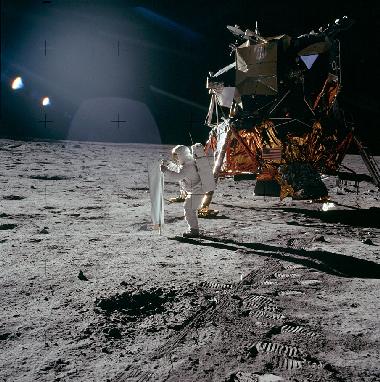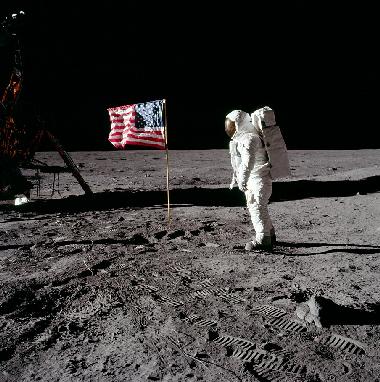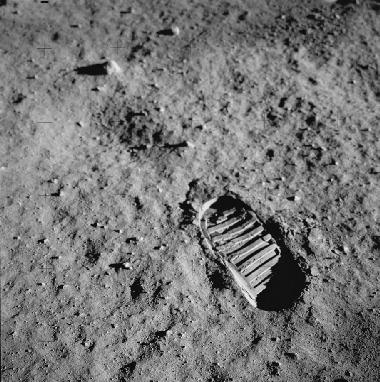-
 Bruce McCandless (CAPCOM)
Bruce McCandless (CAPCOM)
-
This is Houston. We can see Buzz's right hand. It is somewhat out of focus. I'd say we were focusing down to probably—oh, about 8 inches to a foot behind the position of his hand when he was pulling out the cable.
-
 Buzz Aldrin (LMP)
Buzz Aldrin (LMP)
-
And, we'll probably need a little *** distance *** back location *** television camera.
-
 Buzz Aldrin (LMP)
Buzz Aldrin (LMP)
-
Neil, look at the minus Y-strut, the direction of travel there *** travel from right to left.
-
 Buzz Aldrin (LMP)
Buzz Aldrin (LMP)
-
This one over here underneath the ascent engine where the probe first hit—the minus-Y probe first hit.
-
 Buzz Aldrin (LMP)
Buzz Aldrin (LMP)
-
Forty, 50 feet. Why don't you turn around and let them get a view from there and see what the field of view looks like?
-
 Bruce McCandless (CAPCOM)
Bruce McCandless (CAPCOM)
-
Neil, this is Houston. The field of view is okay. We'd like you to aim it a little bit more to the right. Over.
Expand selection up Contract selection down Close -
 Buzz Aldrin (LMP)
Buzz Aldrin (LMP)
-
Okay. That's all the cable we have. *** not going out. I'll start working on the solar wind —
-
 Bruce McCandless (CAPCOM)
Bruce McCandless (CAPCOM)
-
A little bit too much to the right. Can you bring it back left about 4 or 5 Degrees?
-
 Neil Armstrong (CDR)
Neil Armstrong (CDR)
-
Let's try it like that for a while. I'll get a couple of panoramas with it, here.
-
 Bruce McCandless (CAPCOM)
Bruce McCandless (CAPCOM)
-
Roger. You look okay as far as distance goes, Neil. And we'll line you up again when you finish the panorama. Now you're going too fast on the panorama sweep. You're going to have to stop, or -
-
 Neil Armstrong (CDR)
Neil Armstrong (CDR)
-
I haven't stopped—I haven't set it down yet. That's the first picture in the panorama. Right there.
-
 Neil Armstrong (CDR)
Neil Armstrong (CDR)
-
Okay. Now, this one is right down front, straight west. And I want to know if you can see an angular rock in the foreground.
-
 Bruce McCandless (CAPCOM)
Bruce McCandless (CAPCOM)
-
Roger. We have a large angular rock in the foreground, and it looks like a much smaller rock a couple of inches to the left of it. Over.
-
 Neil Armstrong (CDR)
Neil Armstrong (CDR)
-
All right. And then on beyond it about 10 feet is an even larger rock that's very rounded. That rock is about—The closest one to you is about sticking out of the sand about 1 foot. And it's about a foot and one half long, and it's about 6 inches thick, but it's standing on edge.
-
 Neil Armstrong (CDR)
Neil Armstrong (CDR)
-
Roger. The little hill just beyond the shadow of the LM is a pair of elongate craters about—probably the pair together is about 40 feet long and 20 feet across, and they're probably 6 feet deep. We'll probably get some more work in there later.
-
 Buzz Aldrin (LMP)
Buzz Aldrin (LMP)
-
And, incidently, you can use the shadow that the staff makes to *** getting it perpendicular ***
-
 Buzz Aldrin (LMP)
Buzz Aldrin (LMP)
-
Some of these small depressions *** tend to sink—oh, maybe 2 or 3 inches. *** suggest exactly what the Surveyor pictures showed when they pushed away a little bit. You get a force transmitted through the upper surface of the soil and about 5 or 6 inches of bay breaks loose and moves as if it were caked on the surface, when in fact it really isn't.
-
 Neil Armstrong (CDR)
Neil Armstrong (CDR)
-
I noticed in the soft spots where we had footprints nearly an inch deep that the soil is very cohesive and it will retain a—will retain a slope of probably 70 degrees along side of the footprints.
-
 Bruce McCandless (CAPCOM)
Bruce McCandless (CAPCOM)
-
Roger. The EVA is progressing beautifully. I believe they are setting up the flag now.
-
 Bruce McCandless (CAPCOM)
Bruce McCandless (CAPCOM)
-
I guess you're about the only person around that doesn't have TV coverage of the scene.
-
 Bruce McCandless (CAPCOM)
Bruce McCandless (CAPCOM)
-
Yes, indeed. They've got the flag up now and you can see the stars and stripes on the lunar surface.
-
 Buzz Aldrin (LMP)
Buzz Aldrin (LMP)
-
That's good. See if you can pull that end off a little bit. Take that end up a little.
-
 Buzz Aldrin (LMP)
Buzz Aldrin (LMP)
-
I'd like to evaluate the various paces that a person can *** traveling on the lunar surface. I believe I'm out of your field of view. Is that right, now, Houston?
-
 Buzz Aldrin (LMP)
Buzz Aldrin (LMP)
-
Okay. You do have to be rather careful to keep track of where your center of mass is. Sometimes, it takes about two or three paces to make sure you've got your feet underneath you.
Expand selection down Contract selection up -
 Buzz Aldrin (LMP)
Buzz Aldrin (LMP)
-
About two to three or maybe four easy paces can bring you to a nearly smooth stop. *** change directions, like a football player, you just have to to *** foot out to the side and cut a little bit.
-
 Buzz Aldrin (LMP)
Buzz Aldrin (LMP)
-
So-called kangeroo hop does work, but it seems that your forward mobility is not quite as good as—it is in the conventional—more conventional one foot after another.
-
 Buzz Aldrin (LMP)
Buzz Aldrin (LMP)
-
It's hard saying what a sane pace might be. I think it's the one that I'm using now—would get rather tiring after several hundred *** but this may be a function of this suit, as well as lack of gravity forces.
-
 Bruce McCandless (CAPCOM)
Bruce McCandless (CAPCOM)
-
Tranquility Base, this is Houston. Could we get both of you on the camera for a minute, please?
-
 Bruce McCandless (CAPCOM)
Bruce McCandless (CAPCOM)
-
Roger. We'd like to get both of you in the field of view of the camera for a minute.
-
 Bruce McCandless (CAPCOM)
Bruce McCandless (CAPCOM)
-
Key moment President Nixon speaks to Neil and Buzz on the Moon: Neil and Buzz, the President of the United States is in his office now and would like to say a few words to you. Over.
-
 President Nixon
President Nixon
-
Neil and Buzz, I am talking to you by telephone from the Oval Room at the White House, and this certainly has to be the most historic telephone call ever made. I just can't tell you how proud we all are of what you *** for every American. This has to be the proudest day of our lives. And for people all over the world, I am sure they, too, join with Americans in recognizing what an immense feat this is. Because of what you have done, the heavens have become a part of man's world. And as you talk to us from the Sea of Tranquility, it inspires us to redouble our efforts to bring peace and tranquility to Earth. For one priceless moment in the whole history of man, all the people on this Earth are truly one; one in their pride in what you have done, and one in our prayers that you will return safely to Earth.
-
 Neil Armstrong (CDR)
Neil Armstrong (CDR)
-
Thank you, Mr. President. It's a great honor and privilege for us to be here representing not only the United States but men of peace of all nations, and with interest and a curiosity and a vision for the future. It's an honor for us to be able to participate here today.
-
 President Nixon
President Nixon
-
And thank you very much and I look forward—All of us look forward to seeing you on the Hornet on Thursday.
-
 Bruce McCandless (CAPCOM)
Bruce McCandless (CAPCOM)
-
Roger. P22 landmark ID, LM: T1, 110 26 56; T2, 110 32 06. Three miles south; time of closest approach, 110 33 40. Shaft 353.855, trunnion 46.495, roll zero, pitch 250, yaw zero. Over.
-
 Buzz Aldrin (LMP)
Buzz Aldrin (LMP)
-
Houston, it's very interesting to note that when I kick my foot *** with no atmosphere here, and this gravity *** they seem to leave, and most of them have about the same angle of departure and velocity. From where I stand, a large portion of them will impact at a certain distance out. Several *** the percentage is, of course, that will impact *** different regions *** it's highly dependent upon *** the initial trajectory upward *** where most of the *** already the particles are found, … terrain.
-
 Bruce McCandless (CAPCOM)
Bruce McCandless (CAPCOM)
-
Roger, Buzz. And break. Break. Columbia, this is Houston. When you track out of high gain antenna, then let's request OMNI Delta, OMNI Delta. Over.
-
 Buzz Aldrin (LMP)
Buzz Aldrin (LMP)
-
I've noticed several times in going from the sunlight into the shadow, that just as I go in, I catch an additional reflection off the LM *** along with the reflection off my face onto the visor, makes visibility very poor just at the transition *** sunlight into the shadow. I essentially have so much glare coming onto my visor *** shadow *** helmet actually gets the shadow. Than it takes a short while for my eyes to adapt to the lighting conditions. *** inside the shadow area, visibility, as we said before, is not too great, but both visor's up *** what sort of footprints we have and the general condition of the soil. Then, after being out in the sunlight a while, it takes—Watch it, Neil! Neil, you're on the cable.
-
 Buzz Aldrin (LMP)
Buzz Aldrin (LMP)
-
Yes. Lift up your right foot, right foot. It's still—your toe is still hooked in it.
-
 Buzz Aldrin (LMP)
Buzz Aldrin (LMP)
-
The blue color of my boots has completely disappeared now into this *** still don't know exactly what color to describe this other than ash cocoa color. It seems to be covering most of the lighter part of the boot *** color that *** very fine particles ***.
-
 Bruce McCandless (CAPCOM)
Bruce McCandless (CAPCOM)
-
Buzz, this is Houston. You're cutting out on the end of your transmissions. Can you speak a little more closely into your microphone? Over.
-
 Buzz Aldrin (LMP)
Buzz Aldrin (LMP)
-
In general, time spent in the shadow doesn't seem to have any *** thermal effects. *** inside the suit. There is a difference, of course, in the … radiation and the helmet. So I think there's a tendency to feel a little cooler in the shadow than the Sun.
-
 Bruce McCandless (CAPCOM)
Bruce McCandless (CAPCOM)
-
Roger. You should have VHF AOS with the LM right about now. VHF LOS will be about 40 minutes 15 seconds. Over.
-
 Buzz Aldrin (LMP)
Buzz Aldrin (LMP)
-
As I look around the area, the contrast, in general, is *** comes about completely by virtue of the shadow *** down Sun … very light colored gray, light gray color, a halo around my own shadow, around the shadow of my helmet. Then, as I look off across *** the contrast becomes strongest in that the surrounding color is still fairly light. As you look down into the Sun *** a larger amount of *** shadowed area is looking toward us. The general color of the *** surrounding *** the contrast is not as great. Surveying all the dusty area that we've kicked up *** considerably darker in texture. Now, I've kicked up one, and I imagine that this is *** Surveyor. The same is true when I survey across on—along the area that we're walking. In general *** to the fact that there are footprints there. General terrain where I've been kicking up a lot of this surface material is generally of a darker contrast *** color.
Spoken on July 21, 1969, 3:30 a.m. UTC (55 years, 3 months ago). Link to this transcript range is: Tweet



